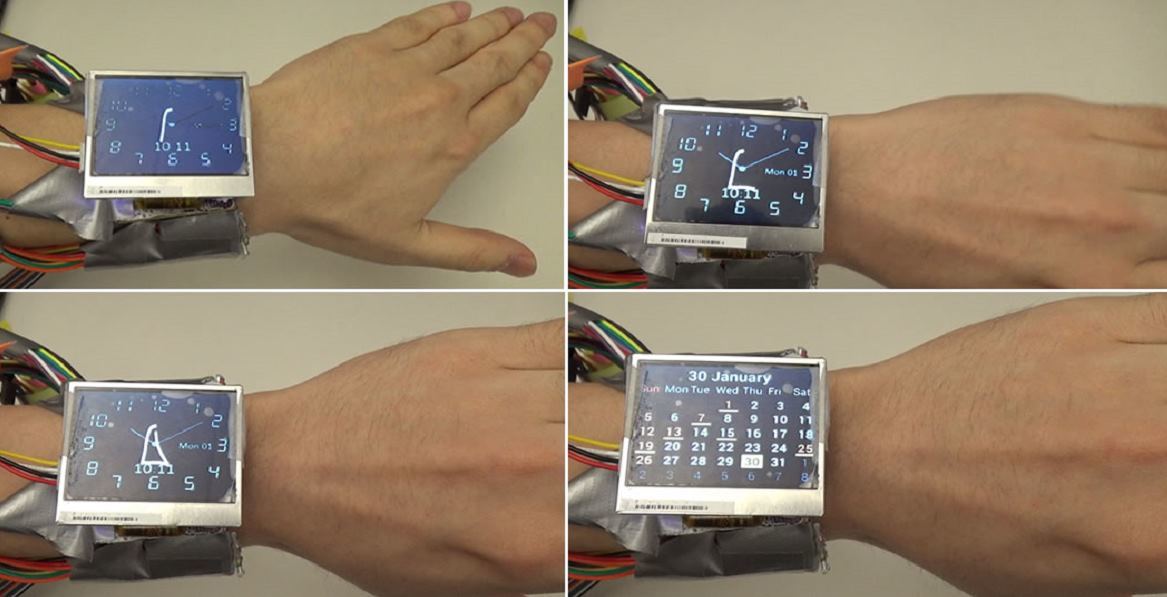WristWhirl: a prototype of a gesture-driven smartwatch

Now there are few who can be surprised with smart electronics. Smart watches, scales, fitness trackers and other gadgets have long been firmly established in the market of electronic devices. True, despite the fact that these devices are positioned by manufacturers, as the last word of technology, they are controlled in the old way. This is especially true for smart watches. All the same touchscreen and control with your fingers or function buttons.
According to some developers, the principle of control of such devices should be fundamentally new. Checking mail, tracking activity during the day, listening to music - all this modern smart watch can do. The development team from Dartmouth has proposed a new way to manage these and other functions and features of the watch - gesture.
To demonstrate their ideas, the developers created a prototype of smart watches of the new type, called WristWhirl . Such a device is controlled by the movements of the human wrist.
')
The presentation of the device will be held on October 19, and now the developers have provided basic information about their project. “While most of the developers of smart watches are only exploring the possibilities of gesture control, WristWhirl already uses it fully. Developments like ours show how smart watches will work in the near future, allowing its owner to interact with the device with one hand, the one on which the watch is worn. The other hand remains absolutely free at this time, ”says Xing-Dong Yang , a professor of computer science at Dartmouth.
When developing the WristWhirl prototype, researchers studied the biomechanical capabilities of the wrist. To test the management system, 15 volunteers aged 15 to 20 years were invited to take part in the project. As it turned out, they all can easily quickly learn how to use gestures to control a computer system.
They were invited to view and repeat eight types of gestures to control smart watches. The project participants put the watch on their left hand, after which they were asked to perform several movements with their wrist. Four types of such movements resembled the usual work with a touchscreen, the other four were drawing geometric shapes in the air.
Volunteers tried to control the clock with the help of gestures, being in a sitting position and standing. They were also asked to perform gestures in two situations - when they saw on the display a drawing of a reproduced gesture without it. This allowed developers to understand how accurately a person performs the desired gesture, if he does not see the result of the execution on the screen. As it turned out, when the performed gesture is drawn on the display, the user of the clock performs all movements more slowly than when a similar gesture is performed without showing it on the screen.
In order to assess the accuracy of the execution of arbitrary gestures using WristWhirl, the developers used a gesture identifier with a price of $ 1. They found that such a device works with 93.8% accuracy. A person recognizes gestures with less accuracy - about 85%.

The WristWhirl configuration includes a 2-inch TFT display and a plastic strap with built-in infrared gap sensors and a piezo-electric vibration sensor. All these elements are located inside the strap. The data received by the sensor is processed by the Arduino DUE board.
The prototype of the watch is far from the commercial model. For example, a 2-inch TFT display is connected here as an external screen to a ThinkPad X1 laptop (Intel Core I7 2.1 GHz, 8 GB RAM). Experimental software installed on the .NET platform and the C # language is installed on the laptop.
During the work, scientists tested WristWhirl while working with Google Maps and various games. In this case, four work scenarios were used:
1. Users could open the application using a gesture;
2. Volunteers could work with music files and music playback using gestures;
3. Map management was done with gestures;
4. Management of games was carried out using gestures.
The authors of the work call the wrist one of the most mobile joints in the human body. The wrist has many degrees of freedom. Due to this, the hand can make circular movements and bend in different directions. Therefore, it is the wrist that can be used as a joystick to control the functions and capabilities of smart watches. The number of different gestures formed with the help of the hand and wrist is very large. Now researchers work with 8 gestures, practicing the device control technology, although in fact there may be several dozens of gestures.

In this case, the watch should be able to distinguish the gesture, with the help of which a person controls the device, from voluntary movements with the palm and wrist.
Developers in their publication say that the management of smart watches with one hand is a new type of interaction with an electronic device. In the near future, the authors of the idea will add a few more to the 8 gestures tested in their work, so that you can control almost all the functions of the watch.
Source: https://habr.com/ru/post/398299/
All Articles